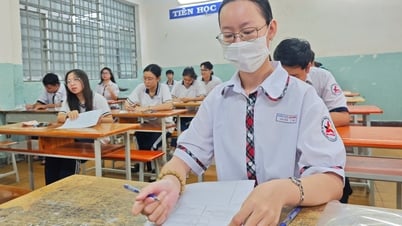
Conference guests
On August 4, in Ho Chi Minh City, the Ministry of Agriculture and Rural Development (MARD) held a conference on cooperation in training and developing agricultural and rural human resources in the southern provinces with the participation of experts, representatives of universities, and enterprises in the agricultural sector...
Increase training facilities
The Ministry of Agriculture and Rural Development said that in recent times, the training and development of human resources in the region has achieved important results. If in 2011, the Mekong Delta region only had 13 highereducation institutions, by 2020 it had increased to 21 higher education institutions with a training scale of nearly 150,000 students. The Southeast region with a training scale of 516,797 students with a rate of 30.2% - ranked second in the country.
Among the universities located in the two regions, there are many universities that train in agriculture, forestry, fisheries, and irrigation, including: Can Tho University, Ho Chi Minh City University of Agriculture and Forestry, Van Hien University, An Giang University, Kien Giang University, Dong Thap University, Branch of Forestry University, Branch of Water Resources University... with majors: Plant protection, animal husbandry, forestry, urban forestry, agronomy, aquaculture, aquatic product processing technology, aquatic product pathology, forest resource management, forest product processing technology, veterinary medicine, agricultural technical pedagogy; agricultural biotechnology... Along with the university system, there are currently many vocational training institutions participating in training human resources for the industry.
Agriculture and rural development in the region, such as: schools under the Ministry of Agriculture and Rural Development and colleges, intermediate schools, vocational education centers - continuing education in provinces and cities. In the period 2016-2022, four out of 28 colleges under the Ministry of Agriculture and Rural Development have trained workers for the Southern provinces at the following levels: nearly 15,000 college level, over 41,000 intermediate level; nearly 53,000 primary and continuing vocational training. In addition, implementing the vocational training program for rural workers, the provinces in the region have trained at all levels with the number of 3,092 people at college level; 11,702 people at intermediate level, 138,149 people at elementary level and 390,136 people trained for less than 3 months. Vocational training under 3 months in the Southeast region is 57,807 people (equal to 7.17% of the country); in the Mekong Delta region is 332,328 people (equal to 41.23% of the country).

Director of Department of Agriculture and Rural Development presented a paper on human resource development in the agricultural sector for the locality.
Labor resources are reduced and quality is not high.
However, training and development of human resources in the agricultural sector is facing difficulties and challenges.
The agricultural, forestry and fishery labor force has been decreasing rapidly in recent times. In the period 2011 - 2020, the agricultural, forestry and fishery labor force of the Southeast region decreased sharply from 1.24 million people in 2011 to 778 thousand in 2020, an average decrease of 46.7 thousand people/year (an average decrease of 3.75% per year). In the Mekong Delta region, the labor force aged 15 and over in the Mekong Delta decreased from 10.2 million people to 9.36 million people (a decrease of 7.2% corresponding to 729.4 thousand people). The reason for this decrease is that workers have migrated out of the region to find jobs in industrial parks and urban areas of other regions.
The quality of agricultural, forestry and fishery workers is generally low. The proportion of workers with technical qualifications from primary vocational level and above in the agricultural, forestry and fishery sector is low, specifically only 7.4% for the Southeast region and 2.21% for the Mekong Delta region. The majority of agricultural, forestry and fishery workers in the region are still unskilled, simple workers, workers working based on experience, seasonal workers, lacking highly skilled workers.
The labor force still lacks skills and professional capacity, and the proportion of laborers who have not been recognized as having national vocational skills is still high. Many students and graduates cannot find jobs that match their training because they do not meet the requirements of employers and the labor market.
The agricultural sector has a decline in the fields of soil science, agricultural extension, animal husbandry, agronomy, crop science, rural development, agricultural economics, and plant protection. For the fisheries sector, there is a sharp decline in the fields of fisheries exploitation, management and exploitation of marine and island resources, and fisheries science. The forestry sector has a sharp decline in the fields of silviculture, forestry, forest resource management, and urban forestry. The irrigation sector has a sharp decline in the fields of water resources engineering, hydrology, hydraulic engineering, and water supply and drainage engineering.
In the coming time, the Ministry of Agriculture and Rural Development will mobilize and effectively use state and social resources to serve the training of high-quality human resources and develop a project to attract high-quality human resources to work in the fields of agriculture and rural development.
Source


![[Photo] General Secretary To Lam receives Chief of the Central Office of the Lao People's Revolutionary Party](https://vphoto.vietnam.vn/thumb/1200x675/vietnam/resource/IMAGE/2025/5/30/140435f4b39d4599a3d17975dfb444c5)
![[Photo] Journalists moved to tears at the Memorial Service for the soldiers who died in Gac Ma](https://vphoto.vietnam.vn/thumb/1200x675/vietnam/resource/IMAGE/2025/5/30/9454613a55c54c16bf8c0efa51883456)


![[Photo] A delegation of 100 journalists from the Vietnam Journalists Association visits the soldiers and people of Truong Sa island district.](https://vphoto.vietnam.vn/thumb/1200x675/vietnam/resource/IMAGE/2025/5/30/0984a986227d4e988177f560d2e1563e)
![[Photo] National Conference "100 years of Vietnamese Revolutionary Press accompanying the glorious cause of the Party and the nation"](https://vphoto.vietnam.vn/thumb/1200x675/vietnam/resource/IMAGE/2025/5/30/1cf6cd5c8a934ebfa347028dcb08358c)
![[Video] Announcing the score distribution of the 2025 HSA Competency Assessment exam](https://vphoto.vietnam.vn/thumb/402x226/vietnam/resource/IMAGE/2025/5/30/8f7b551d1e854f02a1873dcbf7f7a9ef)




















































































Comment (0)